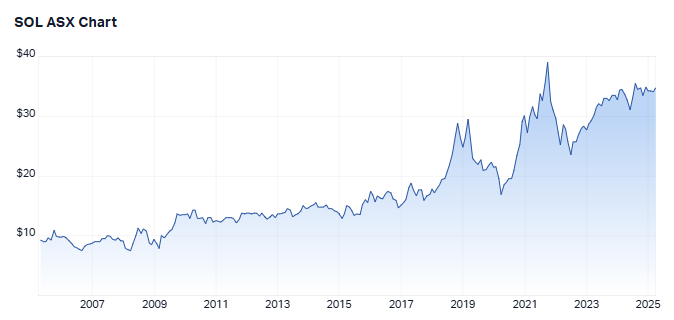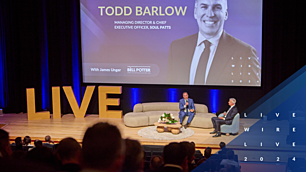Investing like Warren Buffett in an uncertain market
While it’s easy to get caught up in the minutiae of market uncertainty, it’s worth remembering that the market has weathered many chops and changes over time. It can also help to look towards some of the world’s best investors.
There’s a reason why Warren Buffett has long been dubbed the Oracle of Omaha, and the books of both he and Charlie Munger have been an essential for many an investor.
Between 1964 and 2024, Berkshire Hathaway has seen compounded annual growth gains of 19.9% based on per share market value, and total gains of 5,502,284%. It’s a mindblowing number, particularly when you consider that over those decades, Berkshire Hathaway has been managed through a range of crises, such as the 1970s energy crisis, 1980s recession and Black Monday in 1987, the Dotcom bubble, the Global Financial Crisis and Covid-19.
So, what does investing like Buffett look like?
In this wire, I’ll consider both Buffett’s wise tips on investing over the decades and look at the composition of Berkshire Hathaway and how an Australian investor could replicate the portfolio.
5 words of wisdom
It’s hard to narrow down the gems, but I’ve picked out a few that I think are particularly relevant in the current market.
1. “Only when the tide goes out, do you discover who’s been swimming naked”
Uncertainty and volatility are often a good time to really appreciate the fundamentals of a business. Overleveraged companies will struggle, those with good fundamentals will survive.
2. “Someone is sitting in the shade today because someone planted a tree a long time ago.”
Buffett is a big advocate of the concept of getting rich slowly, using compounding and high-quality investments to reach an end goal. While some investors have made extraordinary money out of shorting the market or picking a high-risk, high-growth option, you are also equally likely to lose money in these situations. Buffett has also famously been quoted as saying, “Only buy something that you’d be perfectly happy to hold if the market shut down for 10 years.” If you want to copy Buffett in this instance, it’s about looking at good quality long-term businesses; or for those who have struggled with sitting on an investment for that long, it’s about thinking about the long term strategy for your portfolio.
3. “Predicting rain doesn’t count. Building arks does.”
There are few who can predict exactly when a market will peak or trough. Even the likes of Michael Burry who famously predicted and profited from the US subprime crisis has had his misses – and the timing of the crisis didn’t tie exactly with his predictions. For the majority of us, investing in a way that your portfolio can continue to perform in different market cycles will serve you well in the long term. Typically, that means having adequate diversification across assets, sectors, regions and risk levels as one basic measure of ‘building an ark’.
4. “Look at market fluctuations as your friend rather than your enemy, profit from folly rather than participate in it.”
Everyone knows the quote “Attempt to be fearful when others are greedy, and to be greedy only when others are fearful” and this is another version. Market fluctuations might offer you the chance to crystallise gains or buy into quality at a discount if you keep an eye on the fundamentals of a business. Both can be an opportunity if you take a consistent and measured approach to what you invest in. To invest is to experience market fluctuations and the most successful investors have a careful strategy built to suit them that they hold to across cycles.
5. “Risk comes from not knowing what you’re doing”
If you don’t know what you are doing with your investments, seek help with your investments. This might mean investing your funds with an expert in a particular type of investing, or seeing a financial adviser. Buffett has always been a big advocate of surrounding himself with intelligent people to challenge his decisions, and it’s worth thinking the same way. Similarly, if you don’t understand a particular investment, that could be a sign not to invest – you can’t truly assess the fundamentals or risks if you don’t understand how it works.
The Berkshire Hathaway portfolio
If you take a look at the Berkshire Hathaway assets on the balance sheet in the latest annual report released in February, you’ll note that the two main segments of the business are insurance and railroads, utilities and energy, with the latter being physical companies and assets run by Berkshire Hathaway.
If you look in the Insurance component, you’ll find the following investments:
- Cash and cash like equivalents, along with US Treasury Bills – 42.77%
- Equities – 52.98%
- Fixed maturity securities - 3.05%
- Other – 1.20%
Buffett actually increased his allocation to US Treasury Bills and cash in the last year – while he didn’t shed much light on this in his recent letter to shareholders, some have speculated that this is a sign of the market peaking and Buffett taking gains and holding cash to spend when needed. He sold down from his equity holdings last year, shedding US$80bn from his holdings in Apple alone.
When it comes to equities, Buffett has commented that the largest five equity holdings represent 71% of the total value of the equities portion of the portfolio. These include:
- Amex (NYSE: AXP)
- Apple Inc (NASDAQ: AAPL)
- Bank of America (NYSE: BAC)
- Coca-Cola (NYSE: COKE)
- Chevron (NYSE: CVX)
He holds a relatively concentrated equities portfolio of around 38 equities, which are primarily US stocks. He recently commented on Berkshire Hathaway’s positive view of Japanese equities and his expectation that the company will continue to hold five particular Japanese businesses for decades to come (with the likelihood of these holdings increasing). Berkshire Hathaway currently holds ITOCHU (TYO: 8001), Marubeni (TYO: 8002), Mitsubishi (TYO: 8058), Mitsui (TYO: 8031) and Sumitomo (TYO: 8052).
Turning to the railroads, energy and utilities component, these subsidies of Berkshire Hathway are worth billions. It owns a major North American railroad, Burlington Northern Santa Fe (BNSF) as a significant asset and its energy utilities business spans solar, wind, natural gas, coal, hydroelectric, nuclear and geothermal.
Can you replicate Berkshire Hathaway on the ASX?
The closest option for replicating Berkshire Hathaway as an ASX purchase would be investing in the Global Masters Fund (ASX: GFL) which primarily invests in Berkshire Hathaway shares – it does not pay dividends, because Berkshire Hathaway doesn’t pay dividends. (Side note: Berkshire Hathaway has paid one dividend and that was 10c/share in 1967).
For those who want to try and copy the investments on the ASX, there are a few things to consider. I’ve focused just on equities and the cash components given they form the bulk of the portfolio.
For the equities portion…
You can get exposure to Berkshire Hathaway as well as all the US equity investments Berkshire Hathaway holds via the S&P 500 – though obviously it’s not as concentrated.
ETFs with exposure include:
- iShares S&P 500 ETF (ASX: IVV)
- Vanguard US Total Market Shares ETF (ASX: VTS)
- Betashares S&P 500 Equal Weight ETF (ASX: QUS)
- SPDR S&P 500 ETF Trust (ASX: SPY)
- iShares S&P 500 AUD Hedged ETF (ASX: IHVV)
- Betashares S&P 500 Yield Maximiser Fund (ASX: UMAX)
- Global X S&P 500 High Yield Low Volatility ETF (ASX: ZYUS)
To incorporate Japanese equity exposure:
For exposure to short-term US Treasuries and cash:
- VanEck 1-3 month US Treasury Bond ETF (ASX: TBIL)
- Betashares High Interest Cash ETF (ASX: AAA)
- iShares Core Cash ETF (ASX: BILL)
- iShares Enhanced Cash ETF (ASX: ISEC)
Rather than replicating Berkshire Hathaway, you could also simply follow Buffett’s will where he has reportedly directed that his wealth be invested 90% in an S&P 500 ETF and 10% in 1-3 month US Treasuries. It’s a high-growth strategy so if you need to bolster your portfolio for uncertainty, you’ll need to consider more diversification.
Turning to railroads, energy and utilities...
For rail exposure, the primary Australian option is freight rail transport company Aurizon Holdings (ASX: AZJ).
There are plenty of energy options to sift through. A few examples include:
There are also many utilities businesses on the ASX, with some examples including:
You could also look at ETF bundles of infrastructure investments for exposure to railroads, energy and utilities. These will not necessarily be the same exposure as Buffett’s subsidiaries, but you’ll find access to similar growth drivers. Some listed options follow:
- iShares Core FTSE Global Infrastructure (AUD Hedged) ETF (ASX: GLIN)
- Vanguard Global Infrastructure ETF (ASX: VBLD)
- Lazard Global Listed Infrastructure Fund Active ETF (CBOE: GIFL)
- Global X US Infrastructure Development ETF (ASX: PAVE)
- Magellan Infrastructure Fund (Currency Hedged) (Managed Fund) (ASX: MICH)
- Magellan Core Infrastructure Fund (CBOE: MCSI)
- VanEck FTSE Global Infrastructure (Hedged) ETF (ASX: IFRA)
Insurance…
Insurance is a significant business for Berkshire Hathaway and one that Buffett continues to see ample opportunity in, despite the increasing pressure from natural disasters.
Insurance Australia Group (ASX: IAG) has a five-year reinsurance agreement with one of Berkshire Hathaway’s subsidiaries. It’s an indirect exposure but might be an interesting starting point for research.
A few other insurers to research – if like Buffett, you are interested in the prospects of this industry – include:
Is there an Australian equivalent to Berkshire Hathaway?
Morningstar has previously described Washington H Soul Pattinson (ASX: SOL) as being similar to Berkshire Hathaway.


Or, rather than looking for a match, you could also consider investing with funds or managers that take a similar approach to evaluating companies to Buffett. This would mean taking a MOAT approach - that is, investing in companies with strong competitive advantages such that it would be hard for peers to take market position from them. One example of this is the VanEck Morningstar Wide MOAT ETF (ASX: MOAT) and you can also find a range of active managers who use a MOAT approach as part of their strategy across the market.
What are your thoughts on investing like Buffett? Let me know how you are managing your investments in the comments below.
1 topic
39 stocks mentioned
21 funds mentioned

